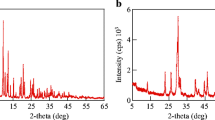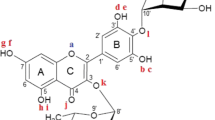We perform the numerical analyses of the geometric and electronic structures of rhamnolipid (obtained as a product of biosynthesis of the Pseudomonas sp. PS-17 bacterial strain) based on the quantum-chemical density functional theory (DFT). We obtain the quantum-chemical parameters of the complexes of rhamnolipid with metals (calcium, zinc, aluminum, and copper), including the total energy of complexes, their heat of formation, the energies of the highest occupied molecular orbital and the lowest unoccupied molecular orbital, the value of the energy gap, ionization potential, distribution of atomic charges according to the Mulliken scheme, and some other derived characteristics. The results of quantum-chemical analyses also demonstrate that complex compounds of rhamnolipid can be formed as a result of its interaction with difficultly soluble calcium phosphate and zinc phosphate with simultaneous release of \( {\mathrm{PO}}_4^{3-} \) anions into the solution. It is shown that rhamnolipid molecules may enhance the anticorrosion effect as a result of facilitation of the electrolytic dissociation of difficultly soluble calcium phosphate and zinc phosphate and the increase in the concentration of phosphate ions in the medium. Moreover, we reveal the possibility of formation of stable rhamnolipid complexes with aluminum ions, which can precipitate on the surface of the metal in the form of a barrier organic layer that prevents their corrosion dissolution.





Similar content being viewed by others
References
P. B. Raja and M. G. Sethuraman, “Natural products as corrosion inhibitors for metals in corrosive media – A review,” Mater. Lett., 62, No. 1, 113–116 (2008).
V. V. Ékilik and V. P. Grigor’ev, Nature of Solvents and Protective Action of Corrosion Inhibitors [in Russian], Rostov University, Rostov (1984).
Z. V. Slobodyan, L. А. Mahlatyuk, R. B. Kupovych, and Ya. M. Khaburs’kyi, “Compositions based on the extracts of oak bark and chips as corrosion inhibitors for medium-carbon steels in water,” Fiz.-Khim. Mekh. Mater., 50, No. 5, 58–65 (2014); English translation: Mater. Sci., 50, No. 5, 687–697 (2015).
E. V. Karpenko, A. N. Shul’ga, and A. A. Turovs’kyi, “Surface-active compounds of the culture of Pseudomonas species PS-17,” Mikrobioloh. Zh., 58, No. 5, 18–24 (1996).
O. V. Karpenko, N. V. Martynyuk, O. M. Shul’ga, T. Ya. Pokyn’broda, R. І. Vil’danova, N. S. Shcheglova, Surface-Active Biopreparation [in Ukrainian], Patent of Ukraine No. 71792 А, MPK С12 N 1/02, C12 R 1/38, Publ. on 15.12.2004, Bull. No. 12.
M. A. Migaheda, M. Abd-El-Raoufa, A. M. Al-Sabagha, and H. M. Abd-El-Bary, “Effectiveness of some nonionic surfactants as corrosion inhibitors for carbon steel pipelines in oil fields,” Electrochim. Acta, 50, 4683–4689 (2005).
V. І. Pokhmurs’kyi, О. V. Karpenko, І. М. Zin’, М. B. Tymus’, and H. H. Veselivs’ka, “Inhibiting action of biogenic surfactants in corrosive media,” Fiz.-Khim. Mekh. Mater., 50, No. 3, 122–127 (2014); English translation: Mater. Sci., 50, No. 3, 448–453 (2014).
G. Gece, “The use of quantum chemical methods in corrosion inhibitor studies,” Corros. Sci., 50, 2981–2992 (2008).
I. B. Obot, N. O. Obi-Egbedi, and S. A. Umoren, “The synergistic inhibitive effect and some quantum chemical parameters of 2,3-diaminonaphthalene and iodide ions on the hydrochloric acid corrosion of aluminum,” Corros. Sci., 51, 276–282 (2009).
K. F. Khaled, “Studies of iron corrosion inhibition using chemical, electrochemical, and computational simulation techniques,” Electrochim. Acta, 55, 6523–6532 (2010).
L. Feng, H. Yang, and F. Wang, “Experimental and theoretical studies for corrosion inhibition of carbon steel by imidazoline derivative in 5% NaCl saturated Ca(OH)2 solution,” Electrochim. Acta, 58, 427–436 (2011).
F. Neese, ‘The ORCA program system,” Wiley Interdiscip. Rev.: Comput. Mol. Sci., 2, 73–78 (2012).
A. D. Becke, ‘Density-functional thermochemistry. III. The role of exact exchange,” J. Chem. Phys., 98 (7), 5648–5563 (1993).
J. J. P. Stewart, ‘Mopac: a semiempirical molecular orbital program,” J. Comput. Aided Mol. Des., 4, No. 1, 1–105 (1990).
A. Klamt and G. Schüümann, “COSMO: A new approach to dielectric screening in solvents with explicit expressions for the screening energy and its gradient,” J. Chem. Soc. Perkin Trans., 2, 799–805 (1993).
E. S. El-Ashry and S. A. Senior, “QSAR of lauric hydrazide and its salts as corrosion inhibitors by using the quantum chemical and topological descriptors,” Corros. Sci., 53, 1025–1034 (2011).
A. S. Fouda1, Y. A. Elewady, H. K. Abd El-Aziz, and A. M. Ahmed, “Corrosion inhibition of carbon steel in 0.5 M HCl solution using cationic surfactants,” Int. J. Electrochem. Sci., 7, 10456–10475 (2012).
I. B. Obot and N. O. Obi-Egbedi, “Adsorption properties and inhibition of mild steel in sulphuric acid solution by ketoconazole: experimental and theoretical investigation,” Corros. Sci., 52, 198–204 (2010).
R. M. Issa, M. K. Awad, and F. M. Atlam, “DFT theoretical studies of antipyrine Schiff bases as corrosion inhibitors,” Mater. Corros., 61, No. 8, 709–714 (2010).
F. Kandemirli and S. Sagdinc, “Theoretical study of corrosion inhibition of amides and thiosemicarbazones,” Corros. Sci., 49, 2118–2130 (2007).
S. Banerjee, V. Srivastava, and M. M. Singh, “Chemically modified natural polysaccharide as green rrosion inhibitor for mild steel in acidic medium,” Corros. Sci., 59, 35–41 (2012).
R. G. Parr and R. G. Pearson, “Absolute hardness: Companion parameter to absolute electronegativity,” J. Amer. Chem. Soc., 105, 7512–7516 (1983).
W. Yang and R. G. Parr, “Hardness, softness, and the Fukui function in the electronic theory of metals and catalysis,” Proc. Natl. Acad. Sci., 82, 6723–6726 (1985).
Author information
Authors and Affiliations
Corresponding author
Additional information
Translated from Fizyko-Khimichna Mekhanika Materialiv, Vol. 52, No. 5, pp. 7–17, September–October, 2016.
Rights and permissions
About this article
Cite this article
Kornii, S.А., Pokhmurs’kyi, V.І., Kopylets’, V.I. et al. Quantum-Chemical Analysis of the Electronic Structures of Inhibiting Complexes of Rhamnolipid with Metals. Mater Sci 52, 609–619 (2017). https://doi.org/10.1007/s11003-017-9998-5
Received:
Published:
Issue Date:
DOI: https://doi.org/10.1007/s11003-017-9998-5




